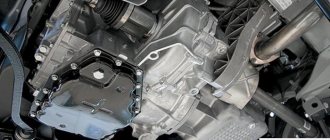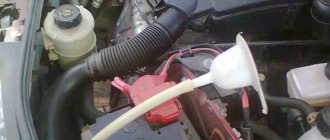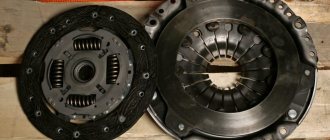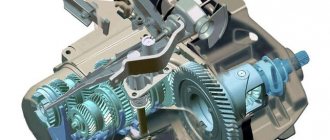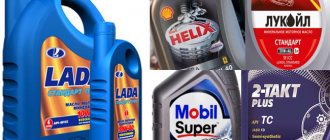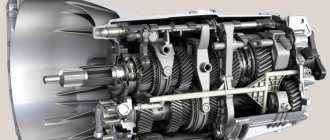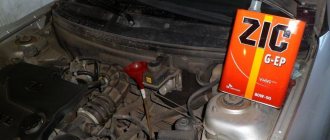The repair and operation manual for Renault Logan, Sandero, Largus, Logan 2, Sandero 2 states that the oil in the manual transmission is filled for the entire service life of the gearbox and does not require replacement. But during operation of the machine, the internal boot of the left drive often fails. The boot becomes tanned in the cold, breaks and water gets into the oil, which requires an oil change.
Replacement process
First of all, we recommend buying a “plug with washer” kit (7703 075 180 VAZ, 7703075180 Renault). The plug closes the drain hole (see fig.
). The required volume for changing is 3.1 liters of oil.
A new plug is screwed in here. To wash away all deposits, the replacement is made on a heated box. And it is better to replace it in the warm season.
The process of changing the oil in a manual transmission in a Renault Sandero Stepway is not very difficult, provided that there are no additional problems. And here it is worth considering one important point: if there are lubricant leaks, the origin of which is unknown, a knock is heard in the box, and after maintenance there are problems with gear shifting, you need to contact a specialist. It is not recommended to carry out repairs yourself if you do not have the necessary skills.
Spark plugs for Renault Logan - we'll tell you step by step It's worth mentioning the tools for changing the oil in a manual transmission in Renault Sandero Stepway. And the list here is very small. You need an 8-square wrench to open the drain hole, a screwdriver to remove the crankcase protection, a 4-5 liter container to remove used oil, and a canister of new lubricant (3-3.5 liters is enough).
Regarding safety precautions, everything is simple and clear:
- The machine must be secured on a level surface. Stoppers are installed under the wheels, the car itself is put into speed and the handbrake is put on. It must be fixed carefully to avoid injuries and other troubles.
- Before work, it is recommended to warm the oil to a warm state to reduce viscosity (especially important in the cold season). But you should not work with a hot manual transmission, to avoid burns due to hot lubricant getting on the skin or accidentally touching the gearbox housing.
- It must be remembered that the oil should not enter the body.
And the process of preparing for draining the liquid is as follows:
- The machine is installed on an overpass or above an inspection hole. It must be fixed according to the principle described above (in the safety regulations).
- Using a screwdriver, remove the screws holding the crankcase guard in place. Then it is removed to the side until the replacement process is completed.
- Place a pre-prepared container under the drain hole.
- Wipe off dust and dirt from the gearbox (in particular, from the filler and drain plugs). During the process, you need to make sure that there are no leaks or damage to the manual transmission.
After completing the described procedures, you can proceed to the actual replacement process.
It is worth mentioning the tools for changing the oil in a manual transmission in Renault Sandero Stepway. And the list here is very small. You need an 8-square wrench to open the drain hole, a screwdriver to remove the crankcase protection, a 4-5 liter container to remove used oil, and a canister of new lubricant (3-3.5 liters is enough).
Let's start with the manufacturer's recommendations!
The manufacturer's recommendations say nothing about the need to change the oil in the box!
The manufacturer believes that the oil will retain its properties throughout the entire life of the vehicle.
But we live in Russia, where there are no roads, a lot of dust and dirt and a temperature difference of 80 degrees, and all these conditions negatively affect the health of cars. Accordingly, when the grenade boots break and the oil seals wear out, dirt, dust and water inevitably get into the gearbox! Naturally, in Russian realities it is better to change the oil in the box, and the owners have experimentally established that this should be done after 60-100 thousand km. mileage or when repairing the box and related elements.
ELF Tranself NFJ 75W80 in the box of Logan 1.4 and 1.6 is 3 liters and it looks like this:
What kind of oil is allowed to be poured into a Logan box when operating in the Russian Federation?
Friends, let's agree that the recommendation of ELF Renault oil is nothing more than a marketing ploy... Oil viscosity is indicated according to SAE, and there is nothing wrong if you fill in high-quality GL4 synthetic oil with a viscosity of 75w-80 from any other manufacturer. The main thing is that the oil is of high quality.
Regarding the problem of choosing between mineral, semi-synthetic and synthetic, you should definitely choose synthetic oil, since it is more stable over the entire temperature range and has a longer service life. Although the author of this article has seen a Logan with a mileage of 280,000 km from a taxi, the owner of which poured Lukoil mineral water into the box, the author does not recommend doing this.
How to change the oil in a Renault Logan manual transmission with a 1.4 engine
We will need:
- Vorotok
- Square as for engine drain plug
- 10mm wrench or socket
- Drain plug gasket
- Oil drain container
- Syringe or funnel for pouring oil.
Sequence of actions when changing the oil in a Logan 1.4 box
— unscrew the engine protection (it’s much easier and faster to work this way)
— prepare a container for draining the oil and unscrew the gearbox drain plug
— drain the oil until it runs out, use pliers to unscrew the filler plug on the box
— after draining the oil as much as possible, screw the drain plug back into place, having first replaced its gasket.
-using a syringe or funnel with a hose, pour oil into the box through the filler plug until it runs back! Usually exactly 3 liters of oil fit into the box.
— wipe excess oil from the box body, tighten the filler plug.
— screw the engine protection into place
- clean the box breather
— enjoy the result and count the money saved.
Well, for clarity, here is a video:
https://youtube.com/watch?v=u4FpzaX1I5I
How to change the oil in a Renault Logan manual transmission with a 1.6 engine
There is no point in writing separate instructions for changing the oil in the box of a Logan with a 1.6 engine, since the boxes differ structurally only in the size of the clutch housing, while the boxes themselves are the same and the filling volume of oil and its type are also the same. Therefore, you can do everything according to the instructions given above.
That's all for me today. Good luck to you, good luck on the roads and good health.
Oil change interval for Lada Largus gearbox
The Lada Largus station wagon went on sale back in 2012. Initially, the manufacturer did not indicate any information on the period for changing the oil in a manual transmission. Arguing this is that the oil is designed for the entire service life of the car and does not require replacement.
In 2014, the maintenance regulations changed, and AvtoVAZ added an item for changing transmission oil in the Lada Largus manual transmission - after 140,000 km. There is no time frame for replacement, only replacement after a certain mileage.
140 thousand kilometers are not covered by the dealer’s warranty, so replacing the transmission oil in the Lada Largus box is entirely the responsibility of the owner.
Although experienced car owners change the oil in the gearbox much earlier - after 60-70 thousand kilometers or after 48 months. In fact, the replacement costs are not so high that it would be worth saving on this to the detriment of the box.
Reliability jh3
The JH3 gearbox is considered a reliable unit, therefore it is still relevant in the automotive market. Car owners prefer cars with a structurally simple gearbox, partly because of its accessible and cheap maintenance. The disadvantages of manual transmission boil down to the lack of a high level of driving comfort.
The gear shift does not always occur clearly and quickly; sometimes there are jolts and jerking of the vehicle. Structurally, the unit has been fully studied, so even in the event of a serious breakdown, its overhaul will not be difficult. Usually the lever for switching from one speed to another becomes loose ahead of time, which leads to unclear switching.
Often, owners of Lada Largus with JH3 note the noisy operation of the manual transmission and a crunching sound when engaging reverse mode. Early wear of the synchronizers cannot be ruled out. If we close our eyes to some shortcomings, we will get decent mechanics that can go 200-300 thousand km without a single repair. There are known examples of cars that have covered about 500 thousand km on JH3 without a single repair. Much depends on your driving style and quality of service. The oil change must be carried out in accordance with the maintenance regulations.
New Lada: Lada Largus and Renault Logan comparison
Step by step replacement
1. Place the machine on a level surface.
2.Unscrew the engine and transmission crankcase protection. In some variations, the protection has a technological hole for unscrewing the drain plug.
3. Clean the gearbox housing from dirt and dust in the drain area and near the filler hole. If drained oil is to be reused, the area near the drain plug must be clean.
4.Unscrew the drain plug using a 8-square. After loosening it with a wrench/ratchet, we recommend turning the plug out manually to quickly remove it from the stream of draining waste. An increase in backlash indicates the end of the thread.
If the color of the drained oil is cloudy, with an emulsion, then there are water impurities in the oil.
5.Use pliers to unscrew the filler plug, which is located at the end of the right side of the box. It is not necessary to change the gasket on this plug.
6.Tighten the drain plug. It is advisable to replace the sealing gasket.
7. To fill in new oil, use a homemade funnel with a piece of hose or a special syringe for filling technical fluids. First pass the hose through the top of the engine compartment, and then direct it from below into the filler hole.
According to the manufacturer's instructions, there is no need to replace the fluid in the Renault LOGAN box. But car owners say otherwise. Owners believe that changing the oil in the Renault Logan gearbox affects the smooth transition from one gear to another.
In Logan, after a run of 100-120 thousand km, the seal density may be disrupted, and the volume of water in the gearbox begins to decrease. Changing the oil in the gearbox (manual transmission) Hyundai Solaris 1.6. According to auto mechanics, this is a more common cause of gearbox failures in Renault.
So if Logan’s gears start sticking in with a crunch, pay attention to the oil level
This can be done by checking the inspection hole. It is located on the box (front of the crankcase). You need to remove the plastic cover and run your hand along the edge of the hole. Changing the gearbox oil in Renault Sandero. If there is enough oil, it will be level with the edge. If the volume of fluid is small, most likely the problem is in the oil seal. Renault Logan oil change: which one to fill in. It needs to be replaced and the oil updated.
Which oil is better to choose for a manual transmission in a Renault Sandero Stepway?
Recommended oil for Renault Logan gearbox
From the factory, oil is poured into the gearbox, which is subsequently recommended for further use. For example, if there is a need to add a substance to the unit.
This mechanical oil has the following properties:
- increased fluidity at low negative temperatures, which allows for simplified gear shifting in winter;
- stable viscosity parameters, eliminating the possibility of noise when changing gearshift lever modes;
- The product contains a formula that allows you to avoid arbitrary shutdown of gears;
- the oil manufacturer guarantees consumers reliable protection of the mechanical components of the unit from rapid wear;
- excellent thermal stability of the product to temperature changes;
- the presence of a complex of additives in the fluid that allows for extreme pressure protection of gear teeth when the unit operates under high load conditions;
- stability of the lubricant product to oxidation;
- protection of internal parts of the gearbox from corrosion.
In automatic transmissions, the car manufacturer recommends using Elf Renaultmatic D3 SYN fluid.
The GARAGE NN channel in its video suggests familiarizing yourself with the procedure for changing the lubricant.
The quality of the oil used should be discussed separately. When filling, only all-season oils are used. Moreover, the liquid should be selected based on its viscosity level. Moreover, the viscosity is determined by the markings on the container with the lubricating fluid. The marking looks something like this: 80w-90 (or 80W90, depending on the manufacturer).
- The first part should be labeled 75w, 80w or 85w. They designate, respectively, the minimum operating temperature of -40, -26 and -12 degrees Celsius. Therefore, it is recommended to fill in oil marked 75w - it is suitable for most regions.
- The second part should be marked 80, 85 or 90. It is worth remembering that in all three cases the maximum operating temperature is considered to be 35 degrees Celsius. But the viscosity of these oils differs. Liquids marked 90 are considered the best in this regard.
All oils (both transmission and motor) are divided into three main types: synthetic, semi-synthetic and mineral. Synthetic lubricants are considered to be of the highest quality - they are recommended for use in Renault Sandero Stepway. It is recommended to use Elf Tranself NFJ 75w-80 API GL-4 fluid.
What does the manufacturer recommend?
Especially for Duster, the manufacturer has provided several lubricant compounds that will be useful in certain climatic zones. So, for operation in harsh conditions, the ELF Tranself TRJ 75W-80 would be an ideal option. This oil was developed in close cooperation with leading companies Renault and Nissan. This oil is designed for a long service life and is very resistant to low temperatures.
An equally high-quality alternative to the above oil would be the ElF Tranself NFJ75W-80 product, which is ideal for both winter and relatively warm weather conditions. Essentially, this is the same as the Tranself TRJ 75W-80 model. The only difference is that this oil is a little cheaper, but is intended only for the Renault Duster five-speed manual transmission.
Adviсe
Before starting work, travel at least 10-15 km so that the oil inside the gearbox warms up and becomes less viscous. If the sealing gasket of the filler plug is not torn and is elastic, it can be reinstalled. Pay attention to the processing status. The presence of an emulsion indicates mixing of oil and water
Often such a nuisance is a consequence of a leak in the boot of the inner CV joint of the left drive shaft. Therefore, inspect the boot for tears or loose clamps. Pay attention to the transmission breather, through which, if installed incorrectly, water and dirt enter the manual transmission. Often, after unqualified repairs, craftsmen neglect the correct installation of the breather. 4.For preventive purposes, rinse and blow out the breather with compressed air. As the pressure inside the transmission increases, a completely clogged "breather" valve can push out. If the malfunction is not noticed in time, dust, dirt and moisture will render the new gear oil unusable.
5. We recommend lubricating the engine protection mounting bolts with graphite grease.
Seal
Before starting work, travel at least 10-15 km so that the oil inside the gearbox warms up and becomes less viscous. If the sealing gasket of the filler plug is not torn and is elastic, it can be reinstalled. Pay attention to the processing status. The presence of an emulsion indicates mixing of oil and water
Often such a nuisance is a consequence of a leak in the boot of the inner CV joint of the left drive shaft. Therefore, inspect the boot for tears or loose clamps. Pay attention to the transmission breather, through which, if installed incorrectly, water and dirt enter the manual transmission. Often, after unqualified repairs, craftsmen neglect the correct installation of the breather.4. For preventive purposes, rinse and blow out the breather with compressed air. As the pressure inside the transmission increases, a completely clogged "breather" valve can push out. If the malfunction is not noticed in time, dust, dirt and moisture will render the new gear oil unusable.
Seal
All the details of changing gearbox oil for Renault (Renault)
Checking the transmission fluid level in the Renault Logan gearbox is a troublesome but simple procedure, which is usually carried out in an inspection pit or on an overpass
It is important to ensure that the car is positioned strictly horizontally, without distortions, otherwise the lubricant will be underfilled
To measure the liquid, you will need the following:
- container for collecting oil;
- flashlight;
- steel rod (probe);
- 8 and 10 mm wrenches.
Then insert a metal rod at a right angle into the filler hole, pull it out and inspect its surface. If the dipstick is clean, there is not enough lubricant. Add liquid using a syringe or funnel, then screw the cap back in.
The first step in properly changing the gearbox fluid is purchasing the right mixture. Remember that transmission mixture and motor oil are different products. And those motorists who calmly pour engine lubricant into the gearbox are at great risk. Before pouring new oil into the Renault Logan box, you need to drive a little, thereby warming up the lubricating fluid and mixing it (with dirt and impurities).
Advantages and features of ELF Tranself NFJ 75W80 oil:
- The formula used in the creation process eliminates the problem of speed jumping;
- Has heat resistance at the highest level;
- Even in the most severe frosts, it retains a liquid structure for easy gear shifting;
- EP additives for gearbox parts retain resistance to loads;
- Protection against corrosion and oxidation;
- Good viscosity stability and resistance to water.
For a safe replacement procedure, it is worth considering these examples of precautions:
- Protective gloves and a gas extraction device must be used;
- It is also necessary to use safety glasses;
- Use only serviceable tools;
- Use a hat if possible.
The list of tools used to change the oil is small:
- 8 mm square wrench.
- Pliers.
- Portable lighting.
- Wire brush.
- 10 mm socket wrench.
- Funnel with hose (0.5 m) or blower.
- Container for draining used oil.
- Axxis Power A LPG 10W-40;
- Azmol Leader Plus 10W-40;
- S-Oil DRAGON SL 10W-40;
- ZIC A 10W-40;
- Pennasol Super Light 10W-40.
Synthetics
- Toyota / Lexus / Daihatsu SN 5W-30;
- Pennasol Super Pace 5W-40;
- Delphi Prestige Plus 5W-40;
- Repsol Elite Multivalvulas 10W-40;
- ZIC X7 LS 10W-40.
- Axxis Power A LPG 10W-40;
- Azmol Leader Plus 10W-40;
- S-Oil DRAGON SL 10W-40;
- Pennasol Super Light 10W-40;
- ZIC A 10W-40.
Synthetics
- Toyota / Lexus / Daihatsu SN 5W-30;
- Pennasol Super Pace 5W-40;
- Repsol Elite Multivalvulas 10W-40;
- Delphi Prestige Plus 5W-40;
- ZIC X7 LS 10W-40.
Synthetics
- Toyota / Lexus / Daihatsu SN 5W-30;
- Pennasol Super Pace 5W-40;
- Repsol Elite Multivalvulas 10W-40;
- ZIC X7 Diesel 10W-40;
- ZIC X7 LS 10W-40;
- Axxis Gold Sint A3/B4 5W-40.
The oil level in Logan 1.4 and 1.6 boxes should be (under normal conditions) up to the filler hole.
How to determine the level. It can only be understood by pouring a little oil into the gearbox filler hole. When it starts to flow back, the box is full.
Criterias of choice
When choosing transmission fluid, pay attention to the specification and viscosity. The API classification is a generally accepted classification that, through testing, determines the effectiveness of extreme pressure and anti-corrosion additives
Elf Tranself NFJ 75W-80 corresponds to class GL-4, which is recommended for use in synchronized manual transmissions of passenger cars. However, it is permissible to use GL-4 and the highest class - GL-5, which is designed for loaded hypoid gears.
The SAE marking shows low-temperature (number with index W) and high-temperature characteristics. 75W formulations are recommended for regions where the temperature does not drop below -40°C. If the car is operated at temperatures not lower than -26°C, oils with an index of 80W are poured into the manual transmission. As for high-temperature characteristics, in regions with a temperate climate, a viscosity grade of 85-90 can be used.
Often it is not possible to pour Elf Excellium, and you have to choose from what is on the shelves. You can take any popular brand with a viscosity of 5W30 and 5W40 (synthetic). Next we will provide a list of budget oils for petrol and diesel Logan.
Boxes for Renault Duster
Renault equips the crossover of the same name with two versions of manual transmissions. We are talking about the five-speed JR5 model, as well as its improved version JR5 TL8 with six gears. Both gearboxes differ only in the number of speeds, while the criteria for choosing a lubricant composition for them are absolutely identical.
The most popular articles on the site:
- How often should you change engine oil?
- Oil 5w30 and 5w40 what is the difference
- What oil to pour into the engine in winter and summer
- How long does it take to change the automatic transmission oil?
Oil change instructions
1. Place the machine on a level surface.
2.Unscrew the engine and transmission crankcase protection. In some variations, the protection has a technological hole for unscrewing the drain plug.
3. Clean the gearbox housing from dirt and dust in the drain area and near the filler hole. If drained oil is to be reused, the area near the drain plug must be clean.
4.Unscrew the drain plug using a 8-square. After loosening it with a wrench/ratchet, we recommend turning the plug out manually to quickly remove it from the stream of draining waste. An increase in backlash indicates the end of the thread.
If the color of the drained oil is cloudy, with an emulsion, then there are water impurities in the oil.
5.Use pliers to unscrew the filler plug, which is located at the end of the right side of the box. It is not necessary to change the gasket on this plug.
6.Tighten the drain plug. It is advisable to replace the sealing gasket.
7. To fill in new oil, use a homemade funnel with a piece of hose or a special syringe for filling technical fluids. First pass the hose through the top of the engine compartment, and then direct it from below into the filler hole.
For models 1.4 and 1.6, the steps will be similar, so this step-by-step instruction will be equally useful for everyone.
- Remove the engine sump protection. We give ourselves convenient access to the necessary components of the car.
- We prepare and place an empty container under the drain plug to drain the used oil.
- Unscrew the drain and fill plug. We are waiting for the complete draining of the used transmission oil.
- We screw all open plugs into place. If the gasket is damaged, it must be replaced with a new one.
- Using a syringe (this is most convenient, but you can also take another device, such as a watering can with a long hose), pour new oil into the gearbox until it flows back out. As written above, 3-3.5 liters will be required.
- We wipe away the stains and tighten the filler plug.
- We install engine protection.
Changing the gearbox oil
Note: the work of checking the level and changing the oil does not differ depending on the modification of the gearbox.
How often to change gearbox oil
Previously, the manufacturer did not require changing the gearbox oil during the entire service life of the vehicle. However, later AvtoVAZ began to include the following instructions in the manuals:
“The manual transmission is filled with transmission oil, which is designed for a service life of 180,000 km of vehicle mileage or 5 years of operation (whichever comes first)”
In addition, due to various reasons, replacement may be necessary (repair, contamination, leakage, or replacement with oil with other characteristics). Also, we must not forget about the need to constantly (at least every 15 thousand km) check the oil level in the gearbox. (see below).
Transmission fluid serves the same purpose as engine oil: it lubricates and cools the components inside the transmission. Transmissions contain gears, clutches and valves that must move smoothly to ensure smooth shifting. Transmission fluid that is dirty and too old can cause rough shifting, strange noises, and uncontrollable vibrations that make driving difficult.
What kind of gearbox oil?
Transmission oils: API quality class: GL-4; GL-5 and SAE viscosity level: 75W80 For example, TRANSELF TRJ 75W-80 oil.
How much oil is in the gearbox
Box JH3 - 2.8 l. Box JR5 - 2.2 l. Box 21809 - 2.25 l.
Level check
Remove the engine protection (central mudguard) (see here)
There is a filler hole on the side surface of the gearbox, which also serves to control the oil level. Closed with a plastic stopper.
Wipe the gearbox housing around the filler (inspection) hole with a rag.
Unscrew the plastic plug (counterclockwise)
The plug has a rubber ring gasket. If it is severely compressed, replace it.
The oil level is checked with your finger. It should be located at the edge of the hole (or a little lower, it can be reached without difficulty)
Replacement
Attention: it is forbidden to pour oil through the breather hole
Place a container under the gearbox with a capacity of at least 3.5 liters. Loosen the drain plug (square “8”)
Note: if you do not have a suitable square wrench, you can grind the M10 bolt
Turn the plug completely and drain the oil.
The drain plug has a copper O-ring. If it is too compressed, replace it.
Wait until the old oil drains completely. Tighten the plug.
Unscrew the plastic filler plug and use a syringe to fill in new oil until it begins to flow out. (approximate volumes are indicated at the beginning)
Note: If you do not have a refill syringe, you can use a piece of clean hose of the appropriate diameter. Insert one end into the filler hole, pull the other end up into the engine compartment and fill in oil using a funnel.
Tighten the plug.
Replace the protection.
Additionally Causes of gearbox oil leaks
If you're having transmission problems, check the fluid first. A transmission fluid leak is no joke. Even though it may seem minor on the outside, it can be a sign of a very serious internal problem. Therefore, it is extremely important to fix it in time and fix it before serious damage to the transmission occurs. Always remember - even the tiniest leak can lead to fatal failure if neglected: when not enough fluid flows through the system, parts will lose vital lubrication, and catastrophic problems will occur inside the transmission.
What are the common causes of these types of leaks? Here is a list of the most likely culprits:
• Transmission pan gasket. In most cases, the cause of a transmission fluid leak is a worn or misaligned transmission pan gasket. It provides a seal between the transmission pan and the bellhousing. This is a simple rubber gasket that wears out naturally over time and requires regular replacement as part of standard transmission maintenance.
• Seals and other gaskets. Various seals and gaskets are used throughout the transmission system. These could be the rear main engine seal and the front inlet seal. The rubber may deteriorate, or something may go out of control and cause transmission fluid to leak.
• Highways. Any transmission ensures a constant flow of fluid throughout the system through the use of various hoses and lines. A poor connection, a break, a breakthrough, a crack always causes a leak.
• Valves and solenoids. The transmission system has valves and solenoids that control the flow of fluid while the vehicle is moving. A damaged part or faulty valve/solenoid can cause transmission fluid to leak.
• Cracks and other damage. Remember that there are quite a few moving parts in the transmission and throughout the vehicle. Pressure shifting, certain extreme loads, etc. can cause cracks in the transmission housing, transmission pan, or elsewhere. This is obviously a serious problem and the damaged parts will need to be repaired or replaced.
Overall, if you notice a transmission fluid leak, don't ignore it. Replacing a worn seal is much cheaper than replacing or rebuilding the entire transmission.
Video
Outsider
There are three types of oil:
- Mineral lubricant is the most affordable product recommended for use in old engines and in cars with high mileage. Various additives containing large amounts of sulfur are added to such oil, and this already suggests low quality oil.
- Semi-synthetic oil is a higher quality product and is considered the best option in terms of quality and price. Such a liquid, however, contains more mineral composition, and therefore it is also better recommended for cars with high mileage.
- Synthetic oil is the best option for the Renault Logan gearbox. This is the most fluid oil that never freezes at low temperatures, unlike the above two types. At the same time, due to its fluidity, such oil penetrates the parts of the box faster and more efficiently and lubricates them. In addition, synthetics are designed for a longer replacement period.
Oil change intervals
Unlike an automatic transmission, in which ATF plays the role of a working fluid, in a manual transmission the oil serves to remove heat and reduce wear on rubbing pairs. But even in this mode of operation, irreversible chemical and physical processes occur; the oil is filled with a suspension of wear products from rubbing metal surfaces. Such negative factors reduce the life of synchronizers and gears. Therefore, it is still necessary to change the oil in manual transmissions, despite Renault service recommendations.
We recommend making the first replacement at 60 thousand km. During the first tens of thousands of kilometers of a vehicle's run, parts are worn in inside the gearbox. After the break-in period, the amount of wear products in the oil decreases, so the interval between subsequent replacements can be increased to 80-100 thousand km.
Video: Changing the oil in a manual transmission on a Renault Logan
Which oil should I buy for Renault Logan mechanics?
Modifications of gearboxes that were used to aggregate Renault Logan with different types of engines do not make any difference when choosing an oil. From the factory, the Logan box is filled with Elf Tranself NFJ 75W-80 fluid.
When selecting an oil change fluid for a manual transmission, the specification and viscosity are taken into account. According to the API classification, it is recommended to use oils with a class of GL-4+, but liquids of classes GL-4 and GL-5 are also allowed.
Motul Motylgear SAE 75W-80
The lubricant viscosity recommended for operation in moderate climates according to the SAE classification is 75W-80, 75W-90, 75W-85.
Among analogues, preference is given to the following oils:
- Castrol Syntrans V FE with a viscosity parameter of 75W-80 and API classification GL-4+;
- Liqui Moly Getriebeoil - 75W-80 (with GL-5 specification);
- Motul Motylgear SAE 75W-80 meets GL-5 standard;
- Shell Getriebeoil EP 75w90 - GL-4;
- Valvoline Maxlife MTF SAE 75W-80 (GL-4);
- Castrol Syntrans Transaxle with viscosity 75W-90 GL-4+.
Valvoline Maxlife MTF SAE 75W-80 (GL-4)
What kind of oil should I use?
On the assembly line, the manufacturer fills the manual transmission with Elf Tranself NFJ 75W-80, which Renault recommends for transmissions of the JXX, TL4 and NDX series.
Renault Logan, Sandero, Logan 2, Lada Largus with 1.4 liter engines were equipped with a jH1 manual transmission, while cars with 1.6 and 1.2 liter engines were equipped with a jH3. Structurally, the units differ in the size of the clutch housing, so this does not affect the choice of gear oil. Less common on cars is the JR5 manual transmission.
For topping up, use only Elf Tranself NFJ 75W-80, since mixing oils is not prohibited. For a complete replacement, it is not necessary to buy original products. You can choose among worthy analogues:
- Liqui Moly Getriebeoil 75W-80 (GL-5);
- Castrol Syntrans Transaxle 75W-90 (GL-4+);
- Motul Motylgear SAE 75W-80 (GL-5);
- Castrol Syntrans V FE 75W-80 (GL-4+);
- Shell Getriebeoil EP 75w90 (GL-4);
- Valvoline Maxlife MTF SAE 75W-80 (GL-4).
The filling volume of gearboxes jH1 and jH3 is 2.8 l, JR5 is 2.5 l. Before purchasing, we recommend that you check this information in the repair and operating manual for your car model.
Disassembling the differential
Now you can start disassembling the differential. To do this, remove the locking ring:
Then take out the glass:
We turn the box over, pull out the oil seal (hitting one edge of the oil seal will warp and then you can pry it up and pull it out), under it there is another retaining ring. It also needs to be dismantled; this ring is pressed by the differential spring washer. To make removal easier, you can clamp the differential gear and housing in a large vice. This will make it easier to remove.
Now the differential is held in place only by seating in the bearings. We put something under the box and knock out the differential, striking the shaft through a drift. In this case, you need to be very careful not to clog the slots. Or better yet, use a straightening hammer. Some people hammer this differential on a piece of wood until it knocks it out
The wide spring ring should be installed as shown in the picture; pay attention to this when assembling. It serves to ensure the required bearing tension
In general, there are two rings, the thin one is stuck to the gear:
We simply knock out the large bearing; in order to press out the small one, you need to remove the speedometer drive and the retaining ring:
We pull up the speedometer shaft with narrow pliers and then take out the gear:
Then we take out the retaining ring and knock out the bearing.
How to change oil
There is no need to add lubricant to a 4 or 5 speed transmission. In accordance with the Renault Logan manufacturer's instructions, you only need to check its level and top up the fluid when servicing the car. However, Russian drivers constantly complain that the left boot, which is connected to the grenade and is washed with box oil, fails.
That’s why the experts “pull the blanket over themselves” - they advise changing the lubricant in the gearbox every 60 km. If you don’t change it, then the gearbox may fail - you will need capital. Due to the considerable cost of both the part itself and the work, replacing the fluid as a preventative measure will definitely save you money!
An oil change in the Logan gearbox is necessary, regardless of breakdowns or high mileage. If you have a new car, you need to change the oil after using the car for six months (or after 15,000 kilometers). Usually, at the factory, the oil in the box is slightly underfilled (according to standards), and while the box is running in, its parts inside (gears) are ground in.
Many people are accustomed to the mandatory change of transmission oil in manual and automatic transmissions. But, there are cars that do not need such frequent fillings, such as Logans. It is necessary to fill the Renault Logan gearbox with oil only in case of repair or complete dismantling of the mechanism.
In this case, the transmission fluid for Logan is selected very carefully in order to match the original as closely as possible. Therefore, having such a car, you need to know everything about how to pour oil into the gearbox.
If the oil seal flies on Logans, then transmission oil is automatically consumed in large quantities. It is then that changing the oil in the gearbox becomes simply necessary. Only high-quality factory oil goes into the Renault Logan box, and remember that you must control the volume so that there is no empty space.
Warm up the engine to operating temperature and then let it cool for 5-7 minutes. The oil drains better and faster if it is not cold. Hot temperatures can burn you, so it’s better to let the engine sit for a while. Open the filler neck of the cylinder block (where we will pour oil) and pull out the dipstick. If you give oxygen through, the liquid will flow out faster. We jack up the car and put it on supports. A necessary step for easy access to the drain plug. You can also use a viewing hole or overpass. Unscrew the drain plug with a wrench
Remember that used oil will be hot and take precautions to avoid skin burns. We pour the waste into the prepared container. Do not dump waste directly onto the ground! Unscrew the oil filter
If the filter is tightly clamped, a special removable filter wrench may be required. We install the new filter after lubricating its sealing ring with oil, and pouring a little oil right into the middle so that it absorbs. The number of the original oil filter is 8200768913. Cheaper analogues that are suitable for Logan: FRAM PH5796, MANN W753, MAHLE C467, FILTRON P6433, PURFLUX LS932 and many others. We tighten the drain plug after making sure that the washer located on its thread is intact. If necessary, it must be replaced (sealing washer). We lower the car from the racks and pour oil into the empty engine, guided by the dipstick. After the poured oil reaches the middle of the dipstick between the MIN and MAX marks, wait 3-5 minutes. Afterwards we warm up the engine for about 5 minutes and measure the level again. As a rule, after the first warm-up the level drops and we add as much as we need.
If they are noticeable, this may indicate wear on the pump. To completely drain the power steering, you can rotate the steering wheel left and right.
Replacing the sensor does not require much effort. At the rear of the cylinder block (where the unit number is indicated), press the wire lock and remove the terminal. The sensor itself is unscrewed with a key x 22. When installing a new sensor, make sure that there is a sealing washer.
This is done during an oil change, at approximately 15 thousand kilometers (officials call this figure). If you change the oil at 10 thousand, then it is better to change the filter to a new one.
Oil selection
This is where many car owners make the most common mistake. It is wrong to assume that all oils are the same, so you can use the first manual transmission fluid you come across.
Yes, in the case of Skoda Octavia, their mechanical transmissions are not the most picky in terms of lubricant selection. But only if the composition meets the requirements of the car manufacturer.
The most important values here are viscosity and API. For Skoda Octavia A5 and A7, you should fill the box with oil with a GL4/GL5 (GL4+) rating and a viscosity of 75W90. These are the optimal characteristics required by mechanics.
Optimal oil for Skoda cars, with an ideal set of characteristics
Now it remains to decide what kind of oil to fill in the manual transmission. The optimal choice would be the original composition. But they don’t buy it often because of its high cost. Many are sure that this is just a commercial move. In fact, the original compositions are no different from analogues from other manufacturers.
This statement cannot be called fair. At the stage of designing and creating gearboxes, Skoda carefully selects all the characteristics and properties of the oil that can optimally match the manual transmission. Many major automakers do this. The result is an oil endowed with specific capabilities and physical and chemical parameters. Other oil manufacturers are trying to get closer to them so that customers have the opportunity to choose formulations other than the original ones.
In the case of the Octavia A5 and A7 models, original VAG oils have the following indices:
- G052512A2;
- G052171A2.
These two compounds are ideal for manual transmissions. Just do not under any circumstances fill the manual transmission with original oils intended for automatic transmissions. The composition there is completely different.
If we talk about alternative solutions, then the Skoda Octavia will do well with oils from leading companies:
- Shell;
- Motul;
- Castrol;
- Elf;
- Liqui Moly, etc.
Focus on viscosity and API parameters. The better quality oil you buy, the fewer problems you will have during the operation of your car. It is not necessary to choose original compositions, but if you have such an opportunity, be sure to take advantage of it.
Required volume
Owners of the Skoda Octavia A5 and A7 with manual gearboxes are a little more fortunate than those with an automatic transmission when it comes to the replacement procedure.
This is due to the amount of lubricant required to fill the oil sump. For automatic transmissions, the oil volume is 6 liters, which is quite a lot and costly from a financial point of view. But car owners have no choice; they must buy and replace. Repairing or replacing an automatic transmission will cost much more.
But if your Skoda Octavia A5 and A7 is equipped with a manual transmission, then it will require several times less lubricant. The filling volume of the manual transmission is 2.0 liters. But when replacing, it is not possible to drain all 2 liters on your own. Part of the lubricant remains inside the system, so in real conditions up to 1.8 liters are usually placed.
There are no exact numbers here, and no one guarantees exactly how much oil will go into the crankcase when replacing it yourself. You need to be guided by the level and build on the individual situation.
Mechanics Renault Arcana 1.6 l JR5
As a manual transmission, the Renault Arcana 1.6 with front-wheel drive has a JR5 gearbox with 5 gears, which was developed directly by Renault. In addition to the crossover, it is also installed on many other models of the Nissan, LADA and Renault brands.
Design
This model is a modernized version of its predecessor – JH3. According to the basic principles, they are very similar - a 2-shaft layout and the presence of synchronizers in all gears. The gearbox is combined with the main gear and differential.
However, there are significant differences:
- The clutch is hydraulically driven, whereas the JH3 had a cable clutch. At the same time, with hydraulics, the clutch engages noticeably softer.
- In the JR5, gears are engaged using 2 cables (flexible), unlike its predecessor, which uses a rigid rod. This solution reduced vibrations.
- The mechanics of the Renault Arcana JR5 are able to handle 200 Nm versus 160 Nm for the previous one.
The markings for this transmission are located on the bottom of the crankcase.
The body itself includes 3 elements:
- Gearbox housing;
- Clutch housing;
- Cover (rear) gearbox housing.
As already mentioned, the design uses a hydraulic clutch drive. In this case, the working cylinder and the clutch release bearing are actuated by one unit, which is fixed to the crankcase with 2 bolts.
An aluminum-based alloy is used to mold the crankcase of the Renault Arcana mechanics and the clutch housing, while the back cover is stamped from steel. Screws are used to secure the clutch housing to the transmission housing. During the assembly process, the joint between the crankcases is coated with a sealant with gasoline and oil resistant characteristics. The rear cover is secured to the gearbox housing using 3 bolts.
The input shaft is a block of drive gears that is in constant mesh with the driven gears at all forward speeds.
The shape of the gears depends on their type:
- Reverse gear – straight teeth;
- The forward drive is helical.
In this case, the gears of the 1st, 2nd, 3rd and 4th gears of the Renault Arcana mechanics work together with the input shaft, while the 5th speed gear rotates on the shaft (freely). The 5th gear synchronizer is located at the rear end of the input shaft. But the secondary shaft is made hollow inside to supply oil through it under the gears (driven).
On the shaft there are gears (driven) of 1st, 2nd, 3rd and 4th gears with synchronizers. But the V speed gear is on splines on the shaft.
The secondary shaft bearings are different, depending on their location:
- Ball - on the side of the lid.
- Roller – from the clutch housing side. Below it is an oil sump to ensure oil flow into the shaft.
Resource
The company claims that the Renault Arcana MT resource is 250,000 km. However, if you properly operate the box and change the oil, it can travel more than 400,000 km.
Problems
As a rule, there are very few problems with manual transmissions. As for the complaints from drivers, they relate to not the most precise operation, vibration at idle and current seals.
Renault JR5 transmission design
This manual transmission is an improved version of the JH3 manual transmission. Structurally, they are very similar, both are made using a two-shaft design, synchronizers are used for all gears, but there are important differences:
- In the old box, the gears are switched using a rigid rod, and in the updated one, with two flexible cables, which reduces vibrations of the unit.
- The clutch is engaged here by a hydraulic drive and it operates much softer than the usual cable of its predecessor.
- the new transmission handles more torque: 200 Nm instead of 160 Nm.
You can find out which gearbox is installed in your car by looking at the identification plate. You can find it on the bottom of the crankcase. The first three digits indicate the gearbox type, then the modification, in the second row its serial number and the manufacturer’s proprietary code.
Video of complete disassembly of the unit and a story about the design features.
Features of fifth gear on Largus
Along with the above malfunctions, Largus owners often have a desire to improve the performance of their car, or more precisely, to adapt it to personal requirements. In the main modification, the Lada Largus gearbox comes with a 16-valve engine. The fifth gear ratio (TR) is 0.892. This indicator indicates that the car can move confidently both in city traffic and outside the city. It easily picks up fifth gear from 50 km/h and dynamically reaches its upper speed limit, so there is almost no need to switch to fourth.
However, when driving for a long time at a speed of 90-100 km/h, increased noise occurs and increased fuel consumption is observed. This situation can be corrected by replacing the two fifth gears on the input and output shafts. Replacement takes place with gears that have a lower gear ratio, therefore, fewer teeth. These pairs of gears are sold in aftermarket gear ratios of 0.820, 0.795, 0.756 and 0.738. Experiments on replacing fifth gear gears were carried out by both AvtoVAZ and numerous car enthusiasts.
Gears with a gear ratio of 0.795 slightly change the maneuverability of the Largus. When overtaking, you need to engage fourth gear more often to gain the desired speed. It is often necessary to switch to four when driving on the ground in a loaded car. As for the installation of gears with an IF of 0.756 and 0.738, they aggravate the listed disadvantages.
It is best to replace the factory gears with a pair with a 0.820 ratio.

